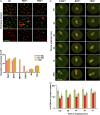Mechanistic basis of infertility of mouse intersubspecific hybrids
- PMID: 23329330
- PMCID: PMC3568299
- DOI: 10.1073/pnas.1219126110
Mechanistic basis of infertility of mouse intersubspecific hybrids
Abstract
According to the Dobzhansky-Muller model, hybrid sterility is a consequence of the independent evolution of related taxa resulting in incompatible genomic interactions of their hybrids. The model implies that the incompatibilities evolve randomly, unless a particular gene or nongenic sequence diverges much faster than the rest of the genome. Here we propose that asynapsis of heterospecific chromosomes in meiotic prophase provides a recurrently evolving trigger for the meiotic arrest of interspecific F1 hybrids. We observed extensive asynapsis of chromosomes and disturbance of the sex body in >95% of pachynemas of Mus m. musculus × Mus m. domesticus sterile F1 males. Asynapsis was not preceded by a failure of double-strand break induction, and the rate of meiotic crossing over was not affected in synapsed chromosomes. DNA double-strand break repair was delayed or failed in unsynapsed autosomes, and misexpression of chromosome X and chromosome Y genes was detected in single pachynemas and by genome-wide expression profiling. Oocytes of F1 hybrid females showed the same kind of synaptic problems but with the incidence reduced to half. Most of the oocytes with pachytene asynapsis were eliminated before birth. We propose the heterospecific pairing of homologous chromosomes as a preexisting condition of asynapsis in interspecific hybrids. The asynapsis may represent a universal mechanistic basis of F1 hybrid sterility manifested by pachytene arrest. It is tempting to speculate that a fast-evolving subset of the noncoding genomic sequence important for chromosome pairing and synapsis may be the culprit.
Conflict of interest statement
The authors declare no conflict of interest.
Figures





References
-
- Dobzhansky T. Genetics and the Origin of Species. 3rd Ed. New York: Columbia Univ Press; 1951.
-
- Muller H, Pontecorvo G. Recessive genes causing interspecific sterility and other disharmonies between Drosophila melanogaster and simulans. Genetics. 1942;27(1):157.
-
- Coyne JA, Orr HA. Speciation. Sunderland, MA: Sinauer Associates; 2004. p. 545.
-
- Maheshwari S, Barbash DA. The genetics of hybrid incompatibilities. Annu Rev Genet. 2011;45:331–355. - PubMed
-
- Haldane J. Sex ration and unisexual sterility in animal hybrids. J Genet. 1922;12(2):101–109.
Publication types
MeSH terms
Associated data
- Actions
LinkOut - more resources
Full Text Sources
Other Literature Sources
Medical
Molecular Biology Databases

